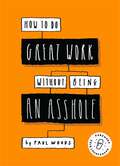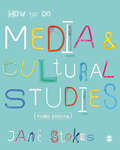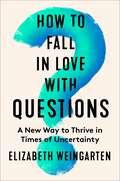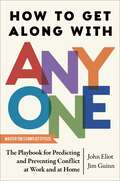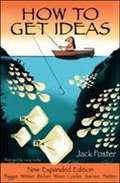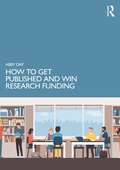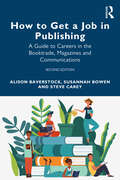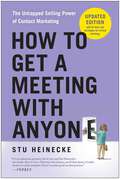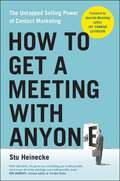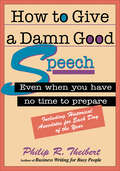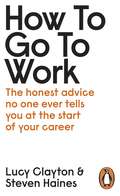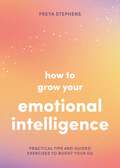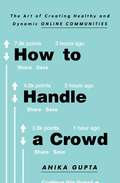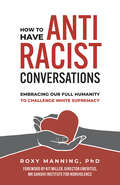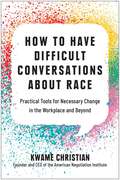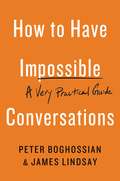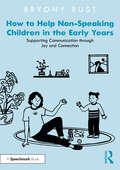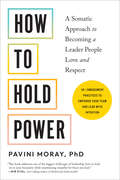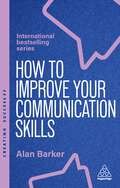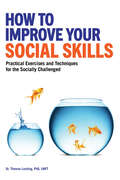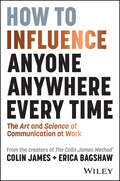- Table View
- List View
How to Do Great Work Without Being an Asshole: (guides For Creative Industries)
by Paul Woods'How to Do Great Work Without Being an Asshole, a new book by designer Paul Woods, is a practical, illustrated guide that does exactly what the title suggests: It shows you how to be both creative and act like a grown-up at work.' - Fast CompanyIt's long been an accepted, almost celebrated, fact of the creative industries that long hours, chaotic workflows and egotistical colleagues are just the price you pay to produce great work. In fact, this toxic culture is the enemy of creativity, and with greater accountability and transparency in the industry - and more choice for young talent - than ever before, this unsustainable way of doing business is a ticking time bomb.This is a straight-talking, fun read for all creatives: Director or junior, at an agency or client-side, working in design, advertising, publishing, fashion or film.Packed with anecdotes, self-analysis flowcharts (are YOU the asshole?!), humorous graphics, and helpful exercises and action plans for better working practices.Simple strategies can easily be implemented to create a happier, more productive team and - importantly - BETTER WORK!Read this guide to develop the ultimate creative process and bring your productivity and teamwork to a new level.How to Do Great Work Without Being an Asshole addresses hot topics like:Building a better office cultureDealing with egosMeeting etiquetteBest practices for pitching and scopingMaking the most of creative briefingsHow to give constructive, clear feedbackGiving better presentations How to approach workloads and long hoursGuidelines for good client relationshipsHiring and being hiredFiring and being firedAnd much more!
How to Do Great Work Without Being an Asshole: (guides For Creative Industries)
by Paul Woods'How to Do Great Work Without Being an Asshole, a new book by designer Paul Woods, is a practical, illustrated guide that does exactly what the title suggests: It shows you how to be both creative and act like a grown-up at work.' - Fast CompanyIt's long been an accepted, almost celebrated, fact of the creative industries that long hours, chaotic workflows and egotistical colleagues are just the price you pay to produce great work. In fact, this toxic culture is the enemy of creativity, and with greater accountability and transparency in the industry - and more choice for young talent - than ever before, this unsustainable way of doing business is a ticking time bomb.This is a straight-talking, fun read for all creatives: Director or junior, at an agency or client-side, working in design, advertising, publishing, fashion or film.Packed with anecdotes, self-analysis flowcharts (are YOU the asshole?!), humorous graphics, and helpful exercises and action plans for better working practices.Simple strategies can easily be implemented to create a happier, more productive team and - importantly - BETTER WORK!Read this guide to develop the ultimate creative process and bring your productivity and teamwork to a new level.How to Do Great Work Without Being an Asshole addresses hot topics like:Building a better office cultureDealing with egosMeeting etiquetteBest practices for pitching and scopingMaking the most of creative briefingsHow to give constructive, clear feedbackGiving better presentations How to approach workloads and long hoursGuidelines for good client relationshipsHiring and being hiredFiring and being firedAnd much more!
How to Do Media and Cultural Studies
by Jane StokesA favourite with both students and lecturers, How to Do Media and Cultural Studies provides readers with all the knowledge and practical expertise they need to carry out their project or dissertation. Giving them hands-on guidance on managing the whole process, Jane Stokes: Shows students how to identify a topic and create a research question Guides them through the research process, from getting started through to writing-up Explores a range a case studies, showing how methods have been applied by others Expanded and updated throughout, this 3rd edition now includes: Increased coverage of digital media, social media and internet research More practical exercises to help you tie media and cultural theory to your work New guidance on understanding research ethics New guidance on mixing and combining methods How to Do Media and Cultural Studies has inspired thousands of students and researchers to understand why studying media texts, industries and audiences is so important. It is an ideal companion for anyone conducting a research project.
How to Do Media and Cultural Studies
by Jane StokesA favourite with both students and lecturers, How to Do Media and Cultural Studies provides readers with all the knowledge and practical expertise they need to carry out their project or dissertation. Giving them hands-on guidance on managing the whole process, Jane Stokes: Shows students how to identify a topic and create a research question Guides them through the research process, from getting started through to writing-up Explores a range a case studies, showing how methods have been applied by others Expanded and updated throughout, this 3rd edition now includes: Increased coverage of digital media, social media and internet research More practical exercises to help you tie media and cultural theory to your work New guidance on understanding research ethics New guidance on mixing and combining methods How to Do Media and Cultural Studies has inspired thousands of students and researchers to understand why studying media texts, industries and audiences is so important. It is an ideal companion for anyone conducting a research project.
How to Fall in Love with Questions: A New Way to Thrive in Times of Uncertainty
by Elizabeth WeingartenJournalist and applied behavioral scientist Elizabeth Weingarten charts a new path to embrace the questions of our lives instead of seeking fast, easy answers.What do you do when faced with a big, important question that keeps you up at night? Many people, understandably, seize answers dispensed by “experts,” influencers, gurus, and more. But these fast, easy, one-size-fits-all solutions often fail to satisfy, and can even cause more pain.What if our questions—the ones we ask about relationships, work, meaning, identity, and purpose—are not our tormentors, but our teachers? Inspired by 150-year-old advice from Austrian poet Rainer Maria Rilke and backed by contemporary science, Elizabeth Weingarten offers a fresh approach for dealing with these seemingly unsolvable questions. In her quest, Weingarten shares her own journey and the stories of many others, whose lives have transformed through a different, and better, relationship with uncertainty.Designed to inspire anyone who feels stuck, powerless, and drained, How to Fall in Love with Questions challenges us to unlock our minds and embark on the kind of self-discovery that’s only possible when we feel most alive—that is, when we don’t know what will happen next.
How to Get Along with Anyone: The Playbook for Predicting and Preventing Conflict at Work and at Home
by John Eliot Jim GuinnDefuse any heated conflict by learning which of the five conflict styles you are and how to resolve even the most sensitive dispute with this must-read guide.The average American worker spends 156 hours a year engaged in the kind of moderate to intense workplace conflict that adversely impacts both performance and health. Managers spend twenty-six percent of their time addressing and resolving conflicts on their team—the equivalent of chewing up one full workday each week. But what if it didn&’t need to be like this? What if there was a way to spend less time in stressfully interpersonal interactions and more time on the things that really matter? Through three decades of building and facilitating team chemistry for Fortune 500 companies, professional sports franchises, schools, government agencies, nonprofit organizations, and families—Drs. Jim Guinn and John Eliot have reduced the time and cost of conflict resolution. With this on-the-ground experience combined with industry-leading science and research, Guinn and Eliot discovered people respond to conflict in one of five ways: avoid, compete, analyze, collaborate, or accommodate. Because our responses are ingrained byproducts of the subcortex in action, they are predictable. If you can predict how someone will behave in a given circumstance, you can formulate a game plan. The secret is knowing which of the five patterns someone is wired to use when smacked by a stressor. How to Get Along with Anyone is a pragmatic hands-on book to help you determine conflict types so you can navigate the arguments that emerge in day-to-day life. You&’ll learn the formula for identifying your coworkers&’ and loved ones&’ conflict styles and how to use this information to foster better communication and more effective, collaboration. Filled with fun, engaging examples and actionable techniques, How to Get Along with Anyone teaches you how to predict and prevent escalated conflict, arming you with practical tools for flipping the script on sticking points to nurture stronger and more meaningful relationships.
How to Get Ideas: Nothing Is More Difficult Than Coming Up with That Original Idea
by Jack FosterWritten by Jack Foster, a creative director for various advertising agencies with more than 40 years experience, How to Get Ideas is a fun, accessible, and practical guide that takes the mystery and confusion out of developing new ideas.
How to Get Published and Win Research Funding
by Abby DayMost journal articles and research proposals are rejected. That represents a waste of everyone’s time, energy, and spirit, especially now when, more than ever, academic careers are precarious. In this practical book, Professor Abby Day addresses these two inter-related and most challenging areas for academics and researchers in their professional careers: how to secure research funding and how to get research published. Reviewers, unpaid and often unappreciated, are over-stretched with their regular academic jobs, and increasingly reluctant to spend time reading poorly constructed papers or proposals. As fewer reviewers are available, the waiting time for a decision increases. Everyone loses. It doesn’t have to be like that. Professor Day’s ground-breaking strategy covers both publishing and funding challenges in similar, yet distinct ways. Lack of time? Conflicting priorities? No idea where to start or what matters most? This book explains how to overcome these and other common obstacles to successful publication and funding. For the first time, one book covers both activities, with practical guidance for setting your strategy and purpose, identifying the right publisher or funder, and understanding your audience and the key criteria for success, as well as helpful advice for writing and managing the challenges of an academic career. This book draws on the first and second editions of two international bestsellers, How to Get Research Published in Journals and Winning Research Funding. Based on original research with editors, funders, and successful academics, plus two decades of running international workshops on publishing and funding, Professor Day has now updated and merged these two critically acclaimed texts. This book is essential reading for graduate students and early career faculty members, who will gain new and effective insights and strategies to secure funding and publication opportunities to help develop their academic careers.
How to Get a Job in Publishing: A Guide to Careers in the Booktrade, Magazines and Communications
by Alison Baverstock Susannah Bowen Steve CareySo you’ve always dreamed of a career in publishing… but you don’t know where to start or how? You’re holding the key in your hands! Using insider information, How to Get A Job in Publishing is the newly revised edition of the classic text for you if you are keen to work in publishing or associated industries – or if you are already in publishing and want to go further. Packed with real-life quotes, case studies and practical advice from publishing veterans, and more recent arrivals, the authors differentiate types of publishing and explain how roles and departments work together. They discuss the pros and cons of internships and further study as well as training and lifelong learning, working internationally, networking and building your personal brand. The book includes vital guidelines for applying for publishing roles, including sample CVs and cover letters and a glossary of industry terms, to make sure you stand out from the crowd when you apply for jobs. This thoroughly updated edition covers: • The post-pandemic publishing world, changes and current controversies, the rise of e-books, Amazon, self-publishing and indie publishing. • The growth in tertiary courses in Publishing Studies and internships – are they really the best way in? • How to create your CV and a compelling cover letter that gets you noticed. A new chapter addresses equity, diversity, inclusion and belonging, reflecting on the current state of the publishing industry, how to evaluate potential employers and how to look after yourself and others at work. Whether you are a new or soon-to-be graduate of Media and Publishing, or are just interested in a career in publishing or the creative industries, How to Get A Job in Publishing is an essential resource.
How to Get a Meeting with Anyone, Updated Edition: The Untapped Selling Power of Contact Marketing
by Stu HeineckeThe hard part just got easy. You know how to sell—that's your job, after all—but getting CEOs and VIPs to call you back is the tricky part. You're in luck: That impossible-to-reach person isn't so impossible to reach after all.Hall-of-Fame-nominated marketer and Wall Street Journal cartoonist Stu Heinecke discovered that he could get past traditional gatekeepers to reach those elusive executives by thinking outside the box and using personalized approaches he calls ""Contact Campaigns."" Including presidents, a prime minister, celebrities, countless CEOs, and even the Danish model who became his wife, Heinecke found that getting meetings with previously unreachable people was easier than ever. Now he shares his tactics and tips in this essential guide for anyone who needs to make contact. Featuring expanded content and brand new chapters, this updated edition of How to Get a Meeting with Anyone explains how you can use your own creative Contact Campaigns to get those critical conversations. He divulges methods he's developed after years of experience and from studying the secrets of others who've had similar breakthrough results—results that other marketers considered impossible, with response rates as high as 100 percent. Through real-life success stories, Heinecke lays out 20 categories of Contact Campaigns that anyone can research and execute. Tactics range from running a contact letter as a full-page ad in The Wall Street Journal to unorthodox uses of the phone, social media, email, and snail mail to using personalized cartoons to make connections. He also packs in plenty of tips on how to determine your targets, develop pitches, and gain allies in your contact's circle of influence. How to Get a Meeting with Anyone provides you with a new toolkit you can put to work right away so you can make the connections that are essential to your success."
How to Get a Meeting with Anyone: The Untapped Selling Power of Contact Marketing
by Stu HeineckeThe hard part just got easy. You know how to sell—that's your job, after all—but getting CEOs and VIPs to call you back is the tricky part. You're in luck: That impossible-to-reach person isn't so impossible to reach after all. Hall-of-Fame-nominated marketer and Wall Street Journal cartoonist Stu Heinecke discovered that he could get past traditional gatekeepers to reach those elusive executives by thinking outside the box and using personalized approaches he calls ""Contact Campaigns."" Including presidents, a prime minister, celebrities, countless CEOs, and even the Danish model who became his wife, Heinecke found that getting meetings with previously unreachable people was easier than ever. Now he shares his tactics and tips in this essential guide for anyone who needs to make contact. In How to Get a Meeting with Anyone, Heinecke explains how you can use your own creative Contact Campaigns to get those critical conversations. He divulges methods he's developed after years of experience and from studying the secrets of others who've had similar breakthrough results—results that other marketers considered impossible, with response rates as high as 100 percent. Through real-life success stories, Heinecke lays out 20 categories of Contact Campaigns that anyone can research and execute. Tactics range from running a contact letter as a full-page ad in The Wall Street Journal to unorthodox uses of the phone, social media, email, and snail mail to using personalized cartoons to make connections. He also packs in plenty of tips on how to determine your targets, develop pitches, and gain allies in your contact's circle of influence. How to Get a Meeting with Anyone provides you with a new toolkit you can put to work right away so you can make the connections that are essential to your success."
How to Give a Damn Good Speech (30-Minute Solutions)
by Philip R. TheibertThe best advice, openings, stories, and facts for a standout speech—from a professional speechwriter for CEOs, political figures, and other top officials.Don’t let the mere thought of presenting a speech tie your stomach in knots and put you in state of sheer panic. Philip Theibert, author of Business Writing for Busy People, has written How to Give a Damn Good Speech to help you give any speech, sounding like a seasoned pro. He provides a blueprint for producing a professional, thought-provoking, friendly, and authoritative speech, even when you have very little time to prepare.How to Give a Damn Good Speech provides you with professional speech writers’ techniques to make each and every speech a powerful presentation. Theibert has done years of research and has read thousands of speeches in an effort to better illustrate his points and bring you the best examples possible. You can read the book in its entirety or, if you simply need a refresher, you can read the section that best suits your needs. This format allows you to focus on areas of your speech that most need help. Topics covered include:How to organize and write a speech100 important things you need to know about giving an effective speechInteresting and entertaining stories to use in any speechBest quotations ever heardHistorical anecdotes for each day of the yearHow to Give a Damn Good Speech, with its easy-to-read, accessible style, makes writing and giving speeches a breeze, and will prevent you from turning green the next time you’re asked to give a speech.
How to Give a Pretty Good Presentation
by T. J. WalkerReduce the time and stress associated with your presentationsBookshelves are crowded with books on how to be an exceptional presenter and promise to produce a brilliant, standing-ovation speaker. But what about a presentation resource for the rest of us? There are so many of us regular folk who who want to spend just a little time and effort to get over the big hurdle of giving a presentation, but don't know where to turn for advice.How to Give a Pretty Good Presentation is the easy answer to this common need. Straightforward, entertaining, and well-organized, this user-friendly resource will walk you step-by-step through the process from how to write, rehearse, and deliver a pretty good presentation that will make you appear confident, memorable, and competent. Although it does not promise the moon (or a standing ovation), this public speaking survival guide will help you:Appear confident (even while still feeling nervous!)Take the spotlight off of you and put it on your contentSave timeNot put people to sleep with your PowerPoint PresentationProduce better resultsMake better impressionsReduce the feelings of dread, sleeplessness, and procrastination associated with your presentationsPrepare even if you've waited until the day before or an hour before your presentation is to be givenWhatever your job, if you need to give a presentation and are feeling overwhelmed by it, How to Give a Pretty Good Presentation is there for you. If you want to reduce the time and stress associated with your presentations now and pass all future presentation opportunities with flying colors, then pick up this fun and accessible guide; you'll no doubt like the resulting improvement in both your personal and professional bottom line.
How to Go Viral and Reach Millions: Top Persuasion Secrets from Social Media Superstars, Jesus, Shakespeare, Oprah, and Even Donald Trump
by Joseph RommHow to Go Viral and Reach Millions is the first book to reveal all the latest secrets for consistently generating viral online content-words, images, or videos that are seen and shared by hundreds of thousands and eventually even millions of people, something Romm and his colleagues in three different organizations achieve routinely.
How to Go to Work: The Honest Advice No One Ever Tells You at the Start of Your Career
by Steven Haines Lucy ClaytonThe definitive careers guide for starting out in today's working worldIt's tougher than ever to get the fundamental skills you need to get started and thrive in your career.Whether you are on your first Saturday shift, about to start an apprenticeship or climbing the leadership ladder, this is your indispensable guide to surviving and thriving at work.Find out what really matters in getting hired for your first job and how to make the best start in your new role. Drawing on the collective wisdom of CEOs, creatives, scientists, activists and professionals in every industry, this is all you need to know about how to go to work.From dealing with your mistakes to celebrating your successes, from making an impression on day one to building your resilience and protecting your values, How to Go to Work is packed full of all the vital advice you need to jump-start your fledgling career. This vital practical guide will show you how to:- Find the right work experience and internships to get you through the door- Present your best self online and in person- Gain confidence, authority and resilience and thrive in your role- Navigate the ups and downs of starting your first or second job and help you make progress in your careerFrom office etiquette and how to make the most of any placement, to employment rights, how to deal with toxic workplaces, pensions and negotiating pay rises, How To Go To Work is the essential guide for anyone embarking upon or consolidating their career.
How to Grow Your Emotional Intelligence: Practical Tips and Guided Exercises to Boost Your EQ
by Summersdale PublishersLearn how to manage your emotions and improve your people skills with this book, which is bursting with advice on emotional intelligence and how to harness itHow to Grow Your Emotional Intelligence is a practical guide filled with tips to help you hone your skills in the four key areas of emotional intelligence.
How to Handle a Crowd: The Art of Creating Healthy and Dynamic Online Communities
by Anika GuptaA guide to successful community moderation exploring everything from the trenches of Reddit to your neighborhood Facebook page. Don&’t read the comments. Old advice, yet more relevant than ever. The tools we once hailed for their power to connect people and spark creativity can also be hotbeds of hate, harassment, and political division. Platforms like Facebook, YouTube, and Twitter are under fire for either too much or too little moderation. Creating and maintaining healthy online communities isn&’t easy. Over the course of two years of graduate research at MIT, former tech journalist and current product manager Anika Gupta interviewed moderators who&’d worked on the sidelines of gamer forums and in the quagmires of online news comments sections. She&’s spoken with professional and volunteer moderators for communities like Pantsuit Nation, Nextdoor, World of Warcraft guilds, Reddit, and FetLife. In How to Handle a Crowd, she shares what makes successful communities tick – and what you can learn from them about the delicate balance of community moderation. Topics include: -Building creative communities in online spaces -Bridging political division—and creating new alliances -Encouraging freedom of speech -Defining and eliminating hate and trolling -Ensuring safety for all participants- -Motivating community members to action How to Handle a Crowd is the perfect book for anyone looking to take their small community group to the next level, start a career in online moderation, or tackle their own business&’s comments section.
How to Have Antiracist Conversations: Embracing Our Full Humanity to Challenge White Supremacy
by Roxy ManningUtilizing Dr. Martin Luther King's Beloved Community framework, activists will be empowered to create change and equity through fierce yet compassionate dialogue against racism and systematic white supremacy.Can a person be both fierce and compassionate at once? Directly challenge racist speech or actions without seeking to humiliate the other person? Interrupt hateful or habitual forms of discrimination in new ways that foster deeper change? Dr. Roxy Manning believes it's possible—and you can learn how. In this book, Dr. Manning provides a new way to conceive of antiracist conversations, along with the practical tools and frameworks that make them possible. Her work is grounded in the idea of Beloved Community, as articulated by Dr. Martin Luther King, Jr., as a goal to aspire to and even experience now, in the present, when we refuse to give up on the possibility of human connection within ourselves, with potential allies, and with those whose words and actions create harm. This book fuels courage and provides tools to confront everyday forms of racism. It walks the reader through an effective, efficient model of dialogue that utilizes concepts of nonviolent communication and helps normalize talking about racism instead of treating it like a "third rail," strictly avoided or touched at one's peril.Readers will Be empowered to identify what kind of antiracist conversation they want to have-for example, do they only want to be heard, or do they want to negotiate a change in policy? Learn how to engage in antiracist conversations whether they are the Actor (person who says or does something racist), the Receiver (the target of racism), or the Bystander. Learn how to notice the underlying needs and values that motivate all human actions and how those values can open up pathways to transformation.Examples of antiracist conversations highlight different ways to initiate dialogue, raise awareness, speak one's truth, and make clear, doable requests or demands for change. Drawing on her experience as a clinical psychologist, a nonviolent communication practitioner, and an Afro-Caribbean immigrant, Dr. Manning provides a model of antiracist dialogue with practical applications for individuals and organizations.
How to Have Difficult Conversations About Race: Practical Tools for Necessary Change in the Workplace and Beyond
by Kwame ChristianIf we want a more equitable workplace—and a more equitable world—we have to talk to each other about race. But, for so many of us, that&’s easier said than done. When we avoid conversations about race, it&’s often because of fear: fear of discomfort, or of damaging important relationships; fear of being misunderstood, &“canceled,&” ostracized. Negotiation expert Kwame Christian&’s motto is: "The best things in life are on the other side of difficult conversations." How to Have Difficult Conversations About Race equips you with the skills you need to make these crucial conversations both easier and more productive. You&’ll not only gain the confidence to talk about race, but also learn how to actually make a difference when you do. Whether you&’re looking to create change for yourself and other BIPOC, or are a white ally seeking to support your coworkers or clients, you&’ll learn how to: Overcome your internal barriers to talking about diversity, equity, and inclusion (DEI). Work around others&’ barriers to productive discussion. Be strategic about the outcome you want and guide the conversation accordingly. Use &“Compassionate Curiosity&” to connect and persuade. Avoid common mistakes. Tackle some of the most common race-related conversations that come up in the workplace. If you&’ve ever struggled to turn your passion for change into persuasion or been too afraid to speak up at work (or outside of it), this book is for you. The first step toward lasting social change is productive discussion. With How to Have Difficult Conversations About Race, you&’ll never shy away from those crucial conversations again.
How to Have Impossible Conversations: A Very Practical Guide
by Peter Boghossian James Lindsay"This is a self-help book on how to argue effectively, conciliate, and gently persuade. The authors admit to getting it wrong in their own past conversations. One by one, I recognize the same mistakes in me. The world would be a better place if everyone read this book." -- Richard Dawkins, author of Science in the Soul and Outgrowing GodIn our current political climate, it seems impossible to have a reasonable conversation with anyone who has a different opinion. Whether you're online, in a classroom, an office, a town hall -- or just hoping to get through a family dinner with a stubborn relative -- dialogue shuts down when perspectives clash. Heated debates often lead to insults and shaming, blocking any possibility of productive discourse. Everyone seems to be on a hair trigger.In How to Have Impossible Conversations, Peter Boghossian and James Lindsay guide you through the straightforward, practical, conversational techniques necessary for every successful conversation -- whether the issue is climate change, religious faith, gender identity, race, poverty, immigration, or gun control. Boghossian and Lindsay teach the subtle art of instilling doubts and opening minds. They cover everything from learning the fundamentals for good conversations to achieving expert-level techniques to deal with hardliners and extremists. This book is the manual everyone needs to foster a climate of civility, connection, and empathy.
How to Help Non-Speaking Children in the Early Years: Supporting Communication through Joy and Connection
by Bryony RustIn every setting there are children who struggle to communicate. When they’re not talking, or only using a handful of words, it can be hard to know how to help. In this book, you’ll be encouraged to spot early moments of communication and respond with clarity. You’ll find an invitation to stop doing and start noticing, to try new things and collaborate with the team around you.The book presents key concepts in bite-size chunks, with a wealth of real-life examples from speech therapy sessions and early years settings. It explores practical strategies to help children develop their foundational speech, language and communication skills, and includes fresh ideas to:· Build honest and supportive conversations with parents about communication needs· Value empathy and imagination as we tune in to each child’s world· Take a pro-neurodiversity lens to inform your practice· Measure progress and support professional development.Communication is core to our sense of wellbeing, personal agency and belonging. With a focus on fostering joyful moments of connection, this book offers a fresh perspective and a dose of encouragement for all early years practitioners, speech and language therapists, SENCOs and key people looking to support positive communication development in the children in their care.
How to Hold Power: A Somatic Approach to Becoming a Leader People Love and Respect--30+ embodiment practices to empower your team and lead with intention
by Pavini MorayEssential skills for today's leaders: learn how to embody your ethics, earn your team's trust, and dismantle toxic work cultureLeaders and managers everywhere are learning the importance of creating safe, satisfying workplaces rooted in principles of social justice. But many of us who try to lead with ethics and integrity struggle with embracing a position of power and authority. You might worry about &“being bossy,&” unintentionally disrespecting others, or making the wrong call—and in the process, put your mind and body under so much stress that you burn out.Somatic educator and coach Pavini Moray argues that the secret to being an ethical, inspirational boss is rooted in our own bodies. In more than 30 simple exercises, reflections, and daily practices, you&’ll learn how to:Nurture trust with clients and coworkersGround and re-center when you&’re thrown off by a mistake or problemSoothe the &“Ouch!&” of negative feedbackBreak away from grind and hustle cultureTurn workplace conflict into a source of positive change and growthHelp your employees voice their own needs and feel heardUnderstand the nuances of consent beyond contract negotiationsGracefully acknowledge mistakesRepair relationships with employees, colleagues, and clientsDrawing from client case studies and their own experience as a manager, Moray teaches foundational embodiment practices—breath, grounding, observing, centering, and moving—through concrete examples that show how to use these skills in a variety of common workplace settings. By learning to practice embodied leadership presence, you can become a boss who truly listens to your employees; leads with inspiration; and brings your whole self to work every day.
How to Improve Your Communication Skills: How to Build Trust, Be Heard and Communicate With Confidence (Creating Success)
by Alan BarkerBetter communication skills will have a direct impact on your career development. Improve Your Communication Skills is your practical guide to effective communication in business.This fully updated 7th edition now features a handy self-assessment tool to help you profile your own preferred communication style, even more practical exercises, useful checklists and top tips, as well as content on influencing others and managing difficult conversations. This book provides vital guidance on improving your conversations, building rapport, giving effective presentations, writing excellent reports and networking successfully. With the help of Improve Your Communication Skills, you will be able to get your message across - every time.The Creating Success series of books...Unlock vital skills, power up your performance and get ahead with the bestselling Creating Success series. Written by experts for new and aspiring managers and leaders, this million-selling collection of accessible and empowering guides will get you up to speed in no time. Packed with clever thinking, smart advice and the kind of winning techniques that really get results, you'll make fast progress, quickly reach your goals and create lasting success in your career.
How to Improve Your Social Skills: Practical Exercises and Techniques for the Socially Challenged
by Thomas Lucking PhD, LMFTFrom socially challenged to socially skilled—practical techniques for building social skills Social skills help build relationships, create opportunities in the world, and improve your self-esteem and overall well-being. How to Improve Your Social Skills is filled with research-supported and evidence-based tools and techniques for building your social skills so you're able to approach any scenario with confidence. Whether you're shy, introverted, socially anxious, or have been diagnosed with a disorder that hinders your interactions with others, you'll discover helpful information about tuning into body language, getting comfortable with conversation, and employing different social skills. Discover ways to apply the skills you learn to real-life situations and relationships, like workplace interactions and friendships. How to Improve Your Social Skills includes: Social skill foundations—Learn about what social skills are, why they matter, how to set social goals, and much more. Evidence-based techniques—Explore tools that will help you overcome anxiety and fear, build confidence and self-awareness, and establish assertive and approachable body language. Situational strategies—Put practice to play in real-life scenarios, including dating, group and public settings, and beyond. Feel confident and empowered in any situation with these research-supported techniques and exercises for building social skills.
How to Influence Anyone, Anywhere, Every Time: The Art and Science of Communication at Work
by Colin James Erica BagshawWe communicate all the time. But do we have impact? Do we influence? When you speak, do people lean in? When they hear you, do others feel impressed, challenged, motivated or inspired? Through tested frameworks and instantly applicable techniques, How to Influence Anyone, Anywhere, Every Time shows you how to use your words and your body language to engage and persuade. With this handbook, you'll learn crucial communication skills for delivering with impact in any professional setting — be it in the boardroom, your next sales meeting or interpersonal interactions. Master how to deliver your message with conviction, confidence and clarity. Globally renowned speaking coaches Colin James and Erica Bagshaw share their proven methodology for wielding influence in any and every context. In How to Influence Anyone, Anywhere, Every Time, they show you how to systematically get and hold people’s attention — and use your influence to achieve positive results in your organisation or business. Whether you’re working face-to-face, you need to create presence online, or you’re crafting a written message, you’ll discover the tips you need. Communicate more effectively with a tried-and-trusted process for success, using the 3 Ds: Diagnose: Who is your audience, what is the context and what is your desired outcome? Design: Get the magic 12 steps that make it easy to tailor your next communication to better engage and influence your audience. Deliver: Don't know what to do with your hands? Learn how to master body language, your voice, visual aids and even your energy for a delivery that will captivate, inspire and persuade even the toughest audience. How to Influence Anyone, Anywhere, Every Time is a must-have resource for anyone who needs to present their ideas, gain trust and bring about real change.
